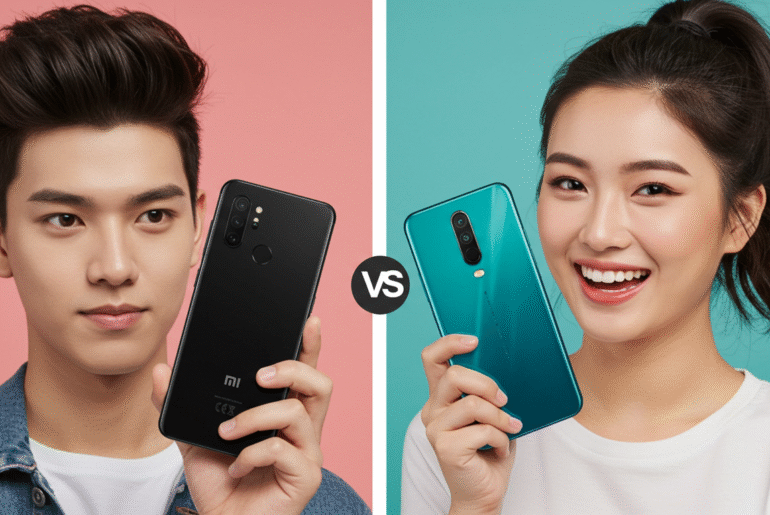This article may contain references to products or services from one or more of our advertisers or partners. We may receive compensation when you click on links to those products or services. Nonetheless, our opinions are our own.
The information presented in this article is accurate to the best of our knowledge at the time of publication. However, information is subject to change, and no guarantees are made about the continued accuracy or completeness of this content after its publication date.
Introduction
If you are shopping for a smartphone in the U.S., Apple and Samsung dominate the market. Xiaomi, however, is gaining attention with high-spec phones at competitive prices. This comparison reviews how Xiaomi stands against Apple and Samsung in 2025, focusing on design, performance, cameras, battery, software, and price.
The Comparison
| Category | Xiaomi | Apple | Samsung |
|---|---|---|---|
| Popular Models (2025) | Xiaomi 15 Ultra, Xiaomi 14T Pro | iPhone 16 Pro / Pro Max | Galaxy S25 Ultra |
| Display Type | AMOLED, LTPO | Super Retina XDR OLED | Dynamic AMOLED 2X |
| Screen Size | 6.67–6.9 in | 6.1–6.7 in | 6.8 in |
| Resolution | 3200 x 1440 | 2796 x 1290 | 3200 x 1440 |
| Display Features | 120Hz refresh, HDR10+, curved edges | ProMotion 120Hz, HDR10, Ceramic Shield | 120Hz refresh, HDR10+, Edge screen |
| Processor | Snapdragon 8 Gen 3 / MediaTek Dimensity 9200+ | A18 Bionic | Snapdragon 8 Gen 3 / Exynos 2500 |
| RAM Options | 8–16GB | 6–8GB | 8–16GB |
| Performance | Flagship-level gaming, AI processing, multitasking | Optimized for iOS, extremely fast in apps and gaming | High-performance Android, excellent for gaming and multitasking |
| Main Camera | 200MP + 50MP ultrawide + 50MP telephoto | 48MP + 12MP ultrawide + 12MP telephoto | 200MP + 12MP ultrawide + 10MP periscope |
| Front Camera | 32MP | 12MP | 40MP |
| Camera Features | AI scene recognition, 8K video, OIS | ProRAW, Cinematic mode, Deep Fusion, 4K video | Super Night, 100x Space Zoom, 8K video |
| Battery Capacity | 5000–6000mAh | 3200–4500mAh | 5000mAh |
| Charging Speed | 120W wired, 50W wireless | 30W wired, 15W MagSafe wireless | 65–120W wired, 50W wireless |
| Special Battery Features | Ultra-fast charging, long endurance | Efficient iOS optimization, fast wireless support | Wireless power-share, fast charging |
| Operating System | MIUI 15 (Android 14) | iOS 18 | One UI 7 (Android 14) |
| Update Policy | 4 years Android, 5 years security | 6 years major updates | 5 years Android, 7 years security |
| Special Software Features | Customizable interface, AI tools | Ecosystem integration, FaceID, security | DeX desktop mode, Knox protection |
| Entry-Level Price (approx. U.S.) | $399 | $799 | $699 |
| Mid-Range Price (approx. U.S.) | $599 | $999 | $899 |
| Flagship Price (approx. U.S.) | $899 | $1,199+ | $1,199+ |
| Overall Strengths | Best value, powerful performance, fastest charging | Best ecosystem, longest updates, reliable cameras | Best balance of Android performance, top displays, versatile cameras |
Voted "Best Overall Budgeting App" by Forbes and WSJ
Monarch Money helps you budget, track spending, set goals, and plan your financial future—all in one app.
Get 50% OFF your first year with code MONARCHVIP
What To Choose
Selecting between Xiaomi, Apple, and Samsung depends on your budget, needs, and preferences. Each brand has clear strengths that appeal to different types of users:
- Xiaomi: A great choice if you want flagship-level performance, long-lasting batteries, and extremely fast charging at a lower price. It is ideal for gamers, heavy users, and budget-conscious buyers who still want premium features.
- Apple: Best suited for those who value ecosystem integration, software longevity, and reliable camera performance. If you already use Apple devices, the iPhone provides seamless compatibility and extended updates.
- Samsung: The right pick if you prefer a premium Android experience with excellent displays, strong cameras, and a balance of power and features. It appeals to users who want versatility and long-term software support.
Your decision comes down to priorities. Choose Xiaomi for affordability and innovation, Apple for ecosystem strength and software support, and Samsung for a balanced flagship experience.
Final Thoughts
Xiaomi, Apple, and Samsung each bring strong advantages to the U.S. smartphone market in 2025. Xiaomi delivers exceptional value with flagship features at lower prices, making it a standout for performance-focused and budget-conscious users. Apple continues to lead in ecosystem integration, software updates, and reliable camera quality, which appeals to those already invested in its products. Samsung offers a well-rounded Android experience with powerful hardware, premium displays, and versatile camera options, balancing performance and innovation.
When deciding, consider your priorities: affordability and speed with Xiaomi, seamless ecosystem and longevity with Apple, or balanced performance and features with Samsung. Each brand offers a strong flagship lineup, ensuring you can find a device that fits your needs and lifestyle.
FAQ
Is Xiaomi available in the U.S. officially?
Xiaomi does not officially sell phones in the U.S. market, but devices can be imported. Apple and Samsung dominate official U.S. retail and carrier channels.
Which brand is better for long-term software support?
Apple leads with up to 6 years of updates. Samsung follows with 5–7 years depending on model, while Xiaomi offers 4 years of Android upgrades and 5 years of security patches.
Which smartphone offers the best value for money?
Xiaomi delivers flagship-level specs at lower prices, making it attractive for value-seeking buyers. Samsung balances features and price, while Apple appeals to ecosystem users.
Which phone has the best camera in 2025?
Samsung and Xiaomi offer high megapixel counts and advanced AI imaging, while Apple emphasizes consistency and strong computational photography results.
Which brand provides the fastest charging?
Xiaomi leads with 120W wired and 50W wireless charging, far ahead of Apple and slightly faster than Samsung’s options.

Reviewed and edited by Albert Fang.
See a typo or want to suggest an edit/revision to the content? Use the contact us form to provide feedback.
At FangWallet, we value editorial integrity and open collaboration in curating quality content for readers to enjoy. Much appreciated for the assist.
Did you like our article and find it insightful? We encourage sharing the article link with family and friends to benefit as well - better yet, sharing on social media. Thank you for the support! 🍉
Article Title: Xiaomi vs Apple vs Samsung Smartphone Comparison 2025
https://fangwallet.com/2025/08/25/xiaomi-vs-apple-vs-samsung-smartphone-comparison-2025/The FangWallet Promise
FangWallet is an editorially independent resource - founded on breaking down challenging financial concepts for anyone to understand since 2014. While we adhere to editorial integrity, note that this post may contain references to products from our partners.
The FangWallet promise is always to have your best interest in mind and be transparent and honest about the financial picture.
Become an Insider

Subscribe to get a free daily budget planner printable to help get your money on track!
Make passive money the right way. No spam.
Editorial Disclaimer: The editorial content on this page is not provided by any of the companies mentioned. The opinions expressed here are the author's alone.
The content of this website is for informational purposes only and does not represent investment advice, or an offer or solicitation to buy or sell any security, investment, or product. Investors are encouraged to do their own due diligence, and, if necessary, consult professional advising before making any investment decisions. Investing involves a high degree of risk, and financial losses may occur including the potential loss of principal.
Source Citation References:
+ Inspo
There are no additional citations or references to note for this article at this time.











































